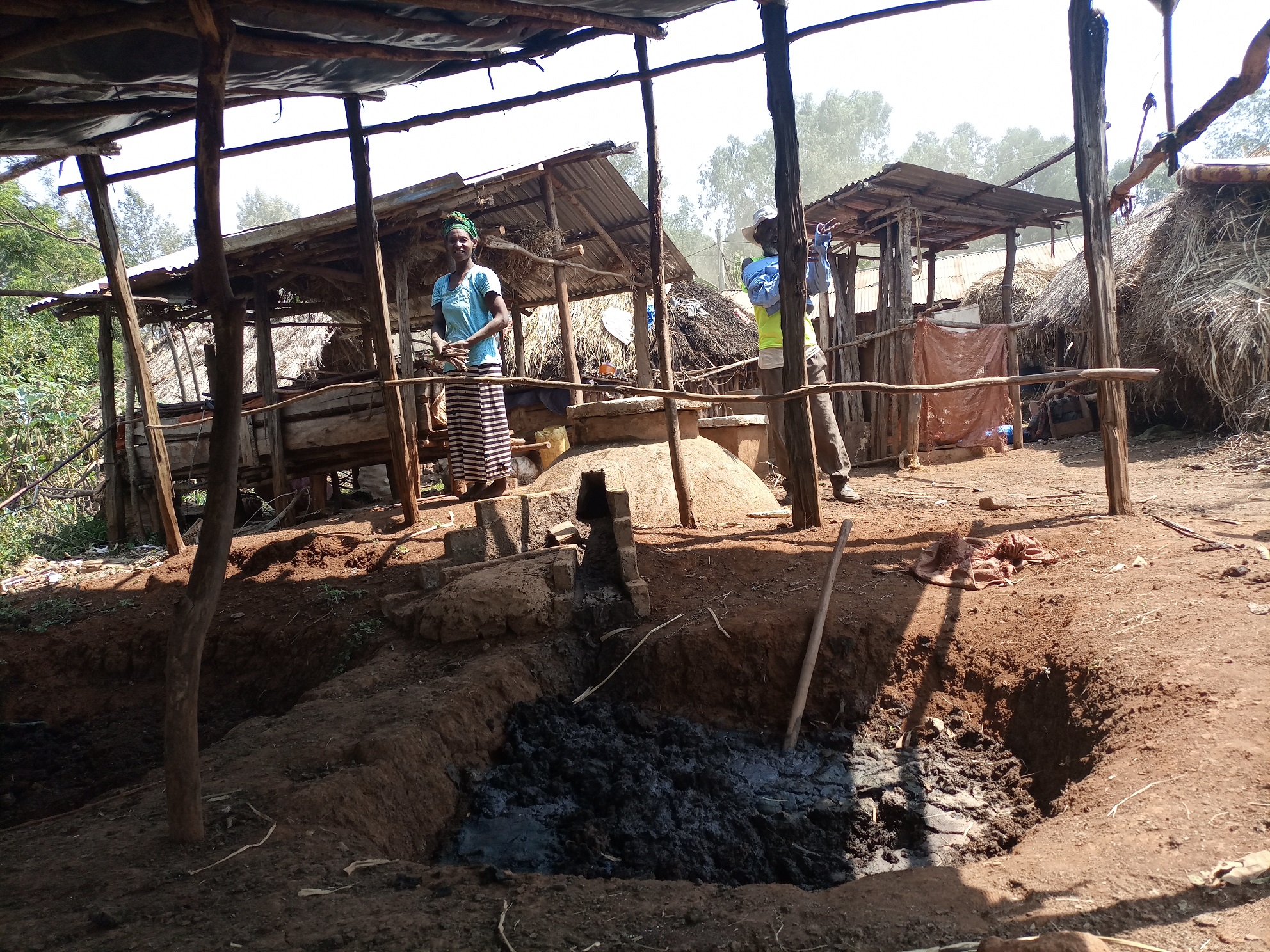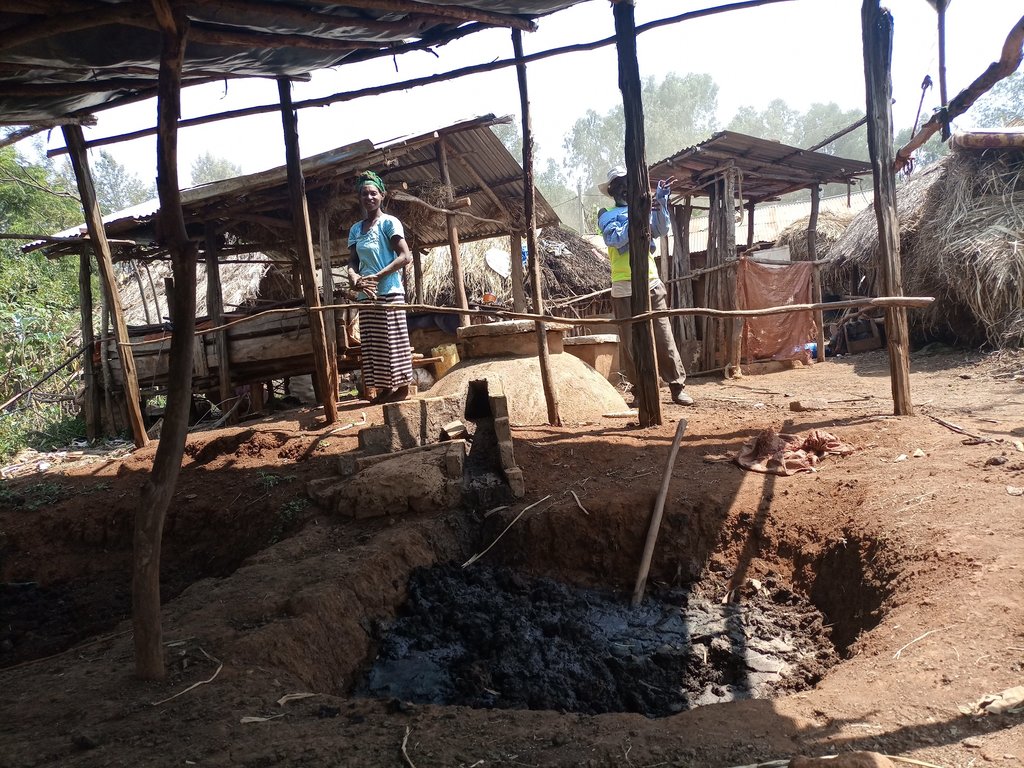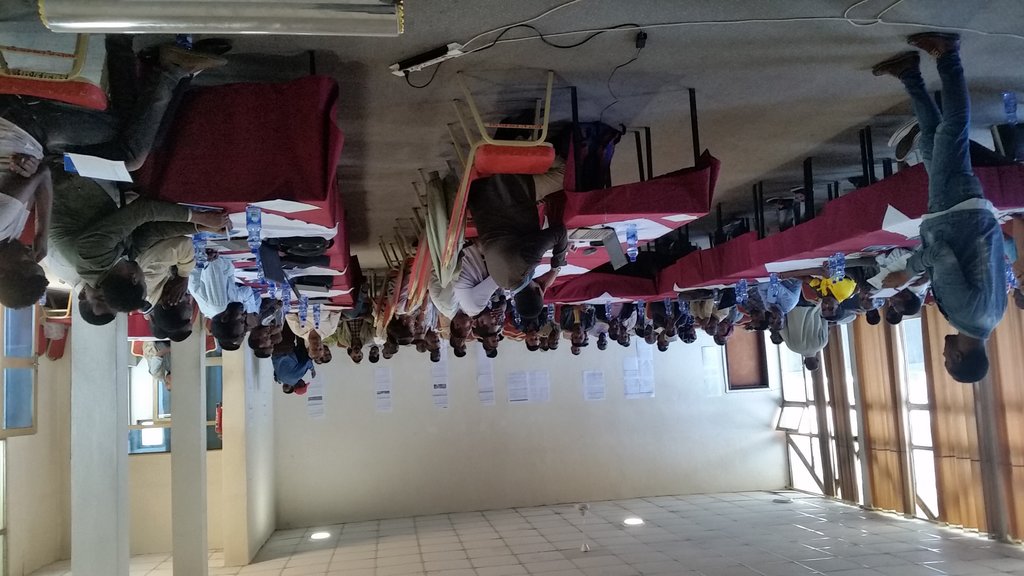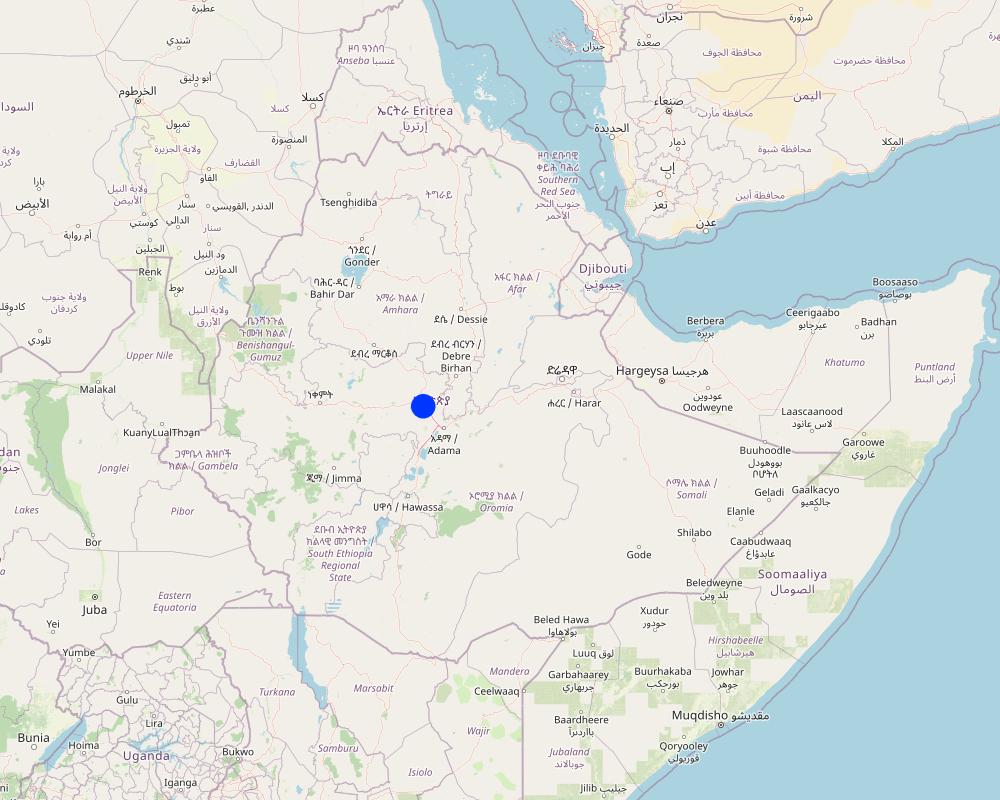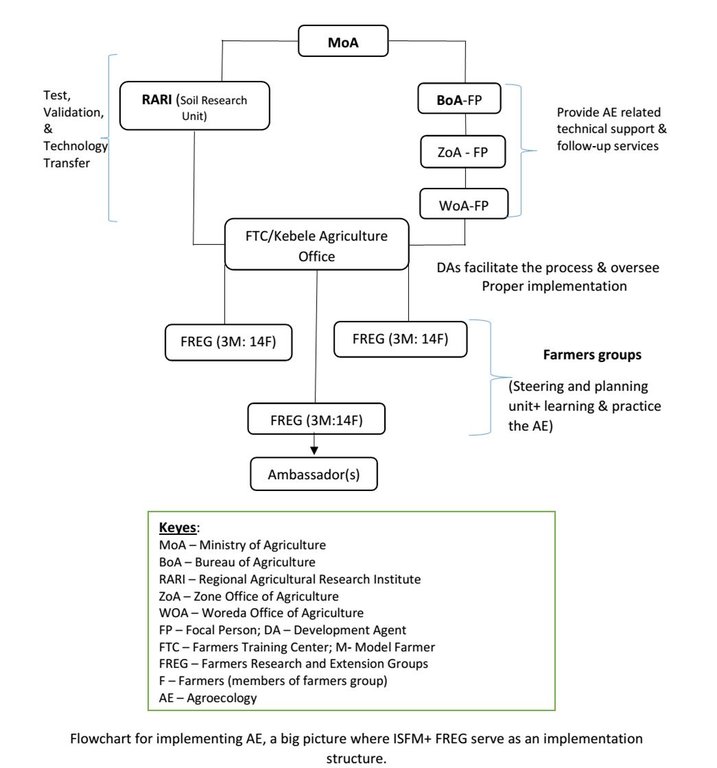Integrated Soil Fertility Management (ISFM) [เอธิโอเปีย]
- ผู้สร้างสรรค์:
- การอัพเดท:
- ผู้รวบรวม: GERBA LETA
- ผู้เรียบเรียง: Noel Templer, Julia Doldt, Torben Helbig, Tabitha Nekesa, Ahmadou Gaye, Siagbé Golli
- ผู้ตรวจสอบ: William Critchley, Rima Mekdaschi Studer, Sally Bunning
Qindoomina Misooma Gabbina Biyyee (Afaan Oromoo) /Yeteqenaje ye Afer Limat (Amharic)
approaches_6732 - เอธิโอเปีย
ดูส่วนย่อย
ขยายทั้งหมด ย่อทั้งหมด1. ข้อมูลทั่วไป
1.2 รายละเอียดที่ติดต่อได้ของผู้รวบรวมและองค์กรที่เกี่ยวข้องในการประเมินและการจัดเตรียมทำเอกสารของแนวทาง
ชื่อของโครงการซึ่งอำนวยความสะดวกในการทำเอกสารหรือการประเมินแนวทาง (ถ้าเกี่ยวข้อง)
Soil protection and rehabilitation for food security (ProSo(i)l)ชื่อของโครงการซึ่งอำนวยความสะดวกในการทำเอกสารหรือการประเมินแนวทาง (ถ้าเกี่ยวข้อง)
Alliance Bioversity and International Center for Tropical Agriculture (Alliance Bioversity-CIAT) - เคนยา1.3 เงื่อนไขที่เกี่ยวข้องกับการใช้ข้อมูลที่ได้บันทึกไว้ผ่านทาง WOCAT
วันที่เก็บรวบรวมข้อมูล (ภาคสนาม):
07/02/2023
ผู้รวบรวมและวิทยากรหลักยอมรับเงื่อนไขเกี่ยวกับการใช้ข้อมูลที่ถูกบันทึกผ่านทาง WOCAT:
ใช่
1.4 การอ้างอิงถึงแบบสอบถามเรื่องเทคโนโลยี SLM
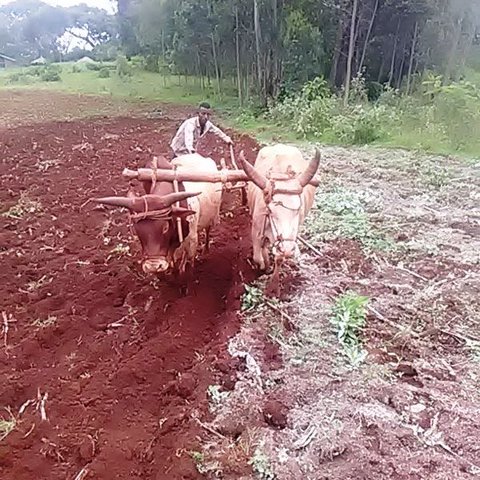
Treating acid soils with lime [เอธิโอเปีย]
Acidic soils deprive crops of their full nutrient absorption capacity. Lime application to these soil makes them less acidic. It breaks the barrier that fixes nutrients and ensures crops access to vital soil nutrients that unleash their productivity potential.
- ผู้รวบรวม: GERBA LETA
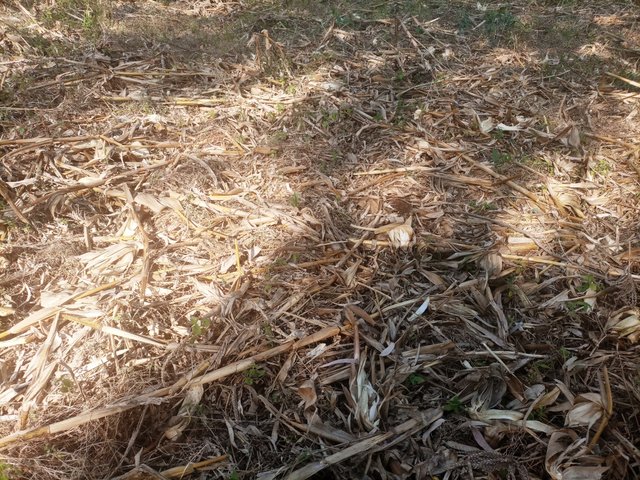
Crop Residue Management [เอธิโอเปีย]
Crop residue management involves leaving stover and other trash from cereal crops (including tef, wheat and maize), as well as haulms of legumes, in the field. Crop residues keep the soil covered, retain organic matter and moisture in the soil, and help to ensure better production.
- ผู้รวบรวม: GERBA LETA
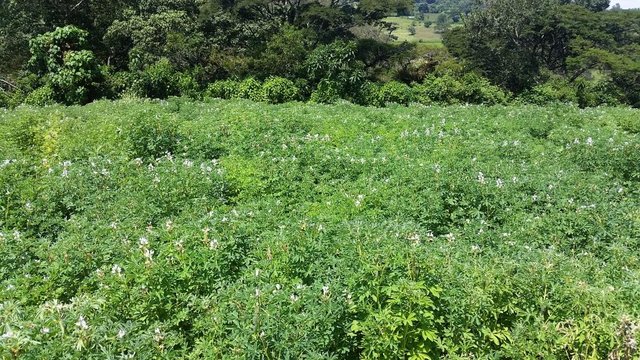
Green Manures [เอธิโอเปีย]
Green manures are fast-growing legumes sown in a field, weeks or even months before the main crop is planted. These are plants that are deliberately grown for incorporation into the soil to improve fertility and organic matter content.
- ผู้รวบรวม: GERBA LETA
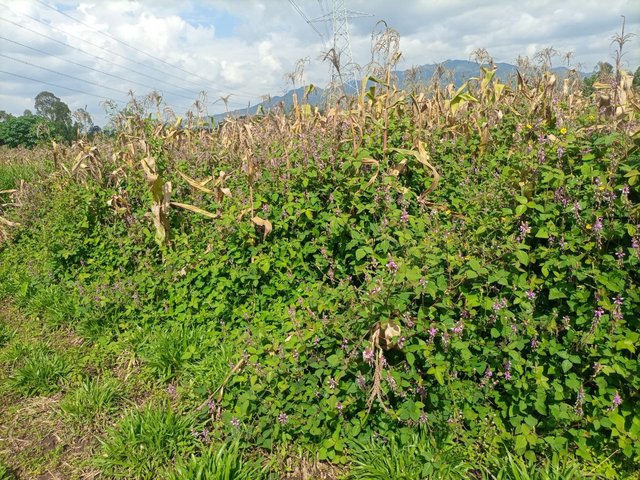
Cover crops [เอธิโอเปีย]
Cover crops are crops grown on bare, fallow farmland or under a main crop to cover and conserve the soil by protecting it from exposure to the sun, wind, and direct impact of rain. It fixes nitrogen (if a legume), improves soil fertility, supplies livestock fodder, and helps manage both …
- ผู้รวบรวม: GERBA LETA

Relay Intercropping [เอธิโอเปีย]
Intercropping is the growing of two or more crops on the same piece of land at the same time or in temporal sequence. Relay intercropping usually involves planting a legume into an established cereal crop. This farming practice has multiple benefits and is a popular among smallholders in Wolaita zone …
- ผู้รวบรวม: GERBA LETA
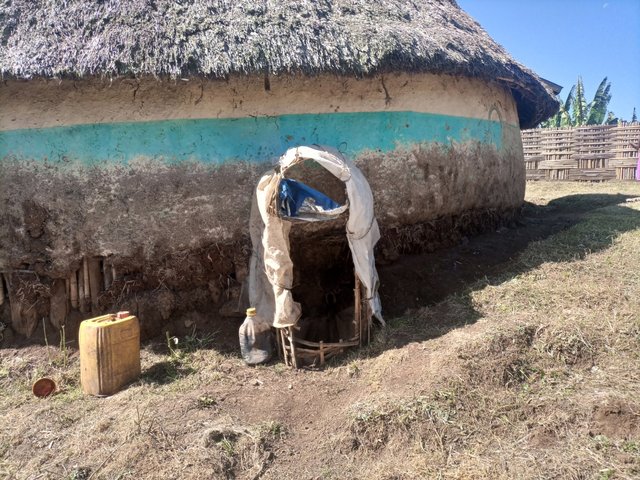
Livestock Urine Collection and Use [เอธิโอเปีย]
Collection of livestock urine allows resource-poor farmers to capture nutrient-rich livestock waste and use it to substitute urea fertilizer. It is a liquid organic product that restores soil fertility and pest management.
- ผู้รวบรวม: GERBA LETA
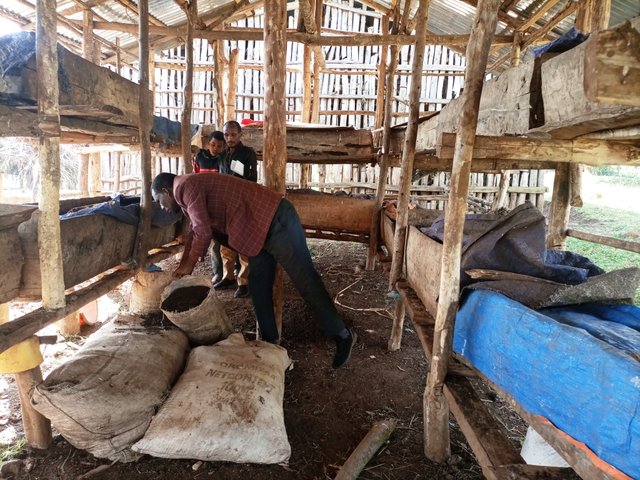
Vermicomposting [เอธิโอเปีย]
Vermicompost is the product of the decomposition process using various species of earthworms. It is a form of humus and is produced through worms digesting and excreting organic in their casts. Vermicompost has been shown to be an effective organic soil amendment, reducing the need for inorganic fertilizers.
- ผู้รวบรวม: GERBA LETA
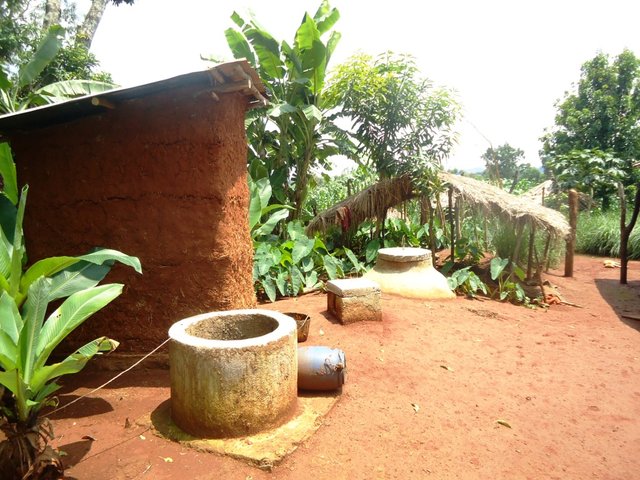
Bioslurry [เอธิโอเปีย]
Bioslurry is a byproduct of the anaerobic process used for production of methane (biogas). It is derived from the manure used to feed the biodigester. Bioslurry is an organic fertilizer that serves as a replacement for chemical fertilizers, and also plays a pesticidal role.
- ผู้รวบรวม: GERBA LETA
2. คำอธิบายของแนวทาง SLM
2.1 การอธิบายแบบสั้น ๆ ของแนวทาง
The Integrated Soil Fertility Management (ISFM) approach has been adopted under the Integrated Soil Fertility Management Project (ISFM+). It was introduced as a quick-win solution to increase both crop and biomass production through the incremental promotion of varied but complementary technology packages.
2.2 การอธิบายอย่างละเอียดของแนวทาง
การอธิบายอย่างละเอียดของแนวทาง:
The Integrated Soil Fertility Management (ISFM) approach is intended to increase both crop and biomass production through the incremental promotion of varied but complementary technology packages. These include the production and use of organic fertilizers, treatment of soil acidity, and improved retention of crop residue. All help in reducing the depletion (mining) of soil nutrients. One characteristic feature is the engagement of research and development partners at all levels such as in joint problem identification, learning, participatory planning, piloting technology, and exchange visits. The approach involves model farmers and also focuses on farmers with limited means to purchase chemical fertilizers. It enhances the production of organic fertilizers to increase both soil fertility and crop productivity. Furthermore, ISFM enables farmers to generate off-farm and on-farm income through the production and sale of organic fertilizers, vermiworms, and green manure seeds, etc. The partners assist in identifying soil-related issues, as well as enhancing the adoption and institutionalization of the approach. ISFM aims to improve stakeholders' understanding of land degradation issues and the necessity of SLM by creating access to relevant seasonal training, exposure visits, collective learning, and action.
Project focal persons representing partners at different levels and development agents (DAs) are used to facilitate the process and serve as potential links with stakeholders. At the local level, the Farmers Research and Extension Group (FREG) sub-approach supports the implementation of the technologies on an incremental basis (see WOCAT database). Also, the Soil Fertility Improvement Cluster approach (see WOCAT database) assists in scaling out of the ISFM approach by adopting and superimposing technologies such as vermicompost with improved compost production. Farmer ambassadors are identified from the FREG model based on their performance. They assist in mainstreaming and dissemination of the approach and technologies to indirect beneficiaries. The implementation process of the ISFM involves district and kebele selection, identification of watersheds and voluntary farmers, provision of capacity-building training, conducting participatory planning, supplying inputs, and technical support. To realize the aims, the ISFM+ allocates financial support to the partners at different levels via Local Subsidy Contract.
Project staff including federal and regional advisors are involved. They provide training, technical backstopping, reviewing progress, M&E, and feedback services. District focal person closely follows up on the implementation - with the support of DAs in steering farmers' group meetings and collective learning. In addition, DAs assist in piloting on farm short and long-term demonstrations, organizing field days and exchange visits, collecting data, and overseeing activities.
Land users like the technologies introduced and implemented via the ISFM approach. The promotion of collective learning and action leads to increased soil fertility, and improved crop production and smallholders' livelihoods. The creation of new sources of income for land users is among the benefits they appreciate the most. However, farmers are less enthusiastic by the way that group meetings clash with their other activities and this leads to some members dropping out. Also, the cost of technologies promoted by the ISFM such as combined uses of chemical fertilizers, bio-fertilizers (for legumes), organic fertilizers, and quality seeds are envisaged as a possible constraint among others.
2.3 รูปภาพของแนวทาง
2.4 วีดีโอของแนวทาง
ความคิดเห็น อธิบายสั้นๆ:
Video of the approach is not documented.
2.5 ประเทศ ภูมิภาค หรือสถานที่ตั้งที่ได้นำแนวทางไปใช้
ประเทศ:
เอธิโอเปีย
ข้อมูลเฉพาะเพิ่มเติมของสถานที่ตั้ง:
Addis Ababa
ความคิดเห็น:
The approach is currently applied in three to four regional states of Ethiopia.
Map
×2.6 วันที่เริ่มต้นและสิ้นสุดของแนวทาง
ระบุปีที่เริ่ม:
2015
ถ้าไม่รู้ปีที่แน่นอนให้ประมาณวันที่ที่ริเริ่มใช้แนวทางนี้ :
น้อยกว่า 10 ปี (เร็วๆนี้)
การสิ้นสุดลง (ถ้าแนวทางไม่ได้ใช้อีกต่อไป):
2025
ความคิดเห็น:
The project will be operational up to 2025.
2.7 ประเภทของแนวทาง
- ใช้โครงงานหรือแผนงานเป็นฐาน
2.8 เป้าหมายหรือวัตถุประสงค์หลักของแนวทาง
The main objective of the approach is to promote the integration of technologies, collective learning, and action for treating degraded soil, increasing soil fertility and crop productivity while ensuring sustainable uses of land.
2.9 เงื่อนไขที่เอื้ออำนวยหรือเป็นอุปสรรคต่อการนำเทคโนโลยีภายใต้แนวทางนี้ไปปฏิบัติใช้
การมีไว้ให้หรือการเข้าถึงแหล่งการเงินและบริการ
- เอื้ออำนวย
Access to financial resources improved farmers' access to materials and inputs on their own. This promotes the adoption and scaling up of the technology using ISFM approach.
การจัดตั้งระดับองค์กร
- เอื้ออำนวย
Institutional setting such as farmers' group formation promotes collective learning and action.
การร่วมมือหรือการทำงานประสานกันของผู้ลงมือปฏิบัติ
- เอื้ออำนวย
Is central to promoting effective implementation of the approach that entails various research and development actors.
นโยบาย
- เอื้ออำนวย
Such as adopting lime production, distribution and use policy enables successful implementation of the approach.
ความรู้เกี่ยวกับ SLM การเข้าถึงการสนับสนุนด้านเทคนิค
- เอื้ออำนวย
ตลาด (จัดซื้อปัจจัยนำเข้า ขายผลิตภัณฑ์) และราคา
- เอื้ออำนวย
ปริมาณงานที่ทำได้ กำลังคนที่มีให้
- เอื้ออำนวย
Family labor enables production of organic fertilizers and effective implementation of lime and other technologies which are labor intensive.
3. การมีส่วนร่วมและบทบาทของผู้มีส่วนได้ส่วนเสียที่เกี่ยวข้อง
3.1 ผู้มีส่วนได้ส่วนเสียที่เกี่ยวข้องในแนวทางนี้และบทบาท
- ผู้ใช้ที่ดินระดับท้องถิ่นหรือชุมชนระดับท้องถิ่น
Model farmers, and other smallholders (followers).
Lead group meeting, facilitate collective learning and action based on the pilot practices/activities.
- ผู้เชี่ยวชาญ SLM หรือที่ปรึกษาการเกษตร
Focal persons and experts from soil fertility improvement /extension unit of the district.
Facilitate implementation of the technology via the approach, and serve as a link between stakeholders.
- นักวิจัย
Soil researchers from Regional Research Institutes, and respective technologies.
Soil testing, production of bio fertilizer, and supporting the different technologies with research findings.
- องค์กรพัฒนาเอกชน
SNV Ethiopia, Nutrition Sensitive Agriculture, and other GIZ projects.
Integration of efforts such as on biogas/bioslurry production and other respective project implementation activities.
- ภาคเอกชน
Agro dealers, and other services providers
Facilitate the distribution of lime and improved seeds, provide services on mechanization such as maintenance, etc.
- รัฐบาลระดับท้องถิ่น
District office of agriculture, and woreda administration.
Partnerships, acknowledge implementation of the project and provide administrative support when required.
- รัฐบาลแห่งชาติ (ผู้วางแผน ผู้ทำการตัดสินใจ)
Ministry of Agriculture and Research System.
Support in mainstreaming the technology and approach, policy formulation and research support testing soil and tools...
- องค์การระหว่างประเทศ
CIAT, CIMMYT, ICRISAT...
Provide research and technical support in joint areas of intervention.
ถ้ามีผู้มีส่วนได้ส่วนเสียหลายคนที่เกี่ยวข้องให้ระบุหน่วยงานตัวแทน:
Integrated Soil Fertility Management Project (ISFM+).
3.2 การเกี่ยวข้องของผู้ใช้ที่ดินระดับท้องถิ่นหรือชุมชนระดับท้องถิ่นในช่วงต่างๆของแนวทาง
| ความเกี่ยวข้องของผู้ใช้ที่ดินระดับท้องถิ่นหรือชุมชนระดับท้องถิ่น | ระบุผู้ที่มีส่วนเกี่ยวข้องและอธิบายกิจกรรม | |
|---|---|---|
| การริเริ่มหรือการจูงใจ | จ่ายเงินหรือสนับสนุนจากภายนอก | District focal person and development agents. Facilitate the implementation right from awareness raising, farmers' group formation, training, supply inputs, and technically support the implementation. |
| การวางแผน | ปฏิสัมพันธ์ | Regional advisor, focal persons, and the farmers. Each engaged in a participatory planning exercise. |
| การดำเนินการ | ปฏิสัมพันธ์ | Farmers, focal persons, and development agents. Farmers implement the technologies being guided by the approach. Whereas, the focal person and development agents oversee and provide technical support. |
| การติดตามตรวจสอบหรือการประเมินผล | ปฏิสัมพันธ์ | Focal person, development agents, and land users. They conduct participatory M&E to ensure collective learning. |
3.3 แผนผังแสดงขั้นตอนการทำงาน (ถ้ามี)
คำอธิบาย:
ISFM approach that run from the federal to kebele where FREG is the pillar approach serving the land users as a platform for collective learning and action at local level.
ผู้เขียน:
Gerba Leta
3.4 การตัดสินใจเลือกใช้เทคโนโลยี SLM
ระบุผู้ที่ทำการตัดสินใจเลือกเทคโนโลยีมากกว่าหนึ่งวิธีไปปฏิบัติใช้:
- ผู้ใช้ที่ดินเป็นผู้ตัดสินใจหลัก โดยการสนับสนุนจากผู้เชี่ยวชาญ SLM
ระบุว่าการตัดสินใจตั้งอยู่บนพื้นฐานของ:
- การประเมินความรู้ SLM ที่ได้ทำการบันทึกไว้เป็นอย่างดี (การใช้ข้อมูลในการตัดสินใจ)
- สิ่งที่ค้นพบจากงานวิจัย
- ประสบการณ์และความคิดเห็นส่วนตัว (ไม่ได้ลงบันทึกไว้)
4. การสนับสนุนด้านเทคนิค การสร้างขีดความสามารถ และการจัดการด้านความรู้
4.1 การสร้างขีดความสามารถ / การอบรม
ได้มีการจัดอบรมให้แก่ผู้ใช้ที่ดินหรือผู้มีส่วนได้ส่วนเสียคนอื่น ๆ หรือไม่:
ใช่
ให้ระบุว่าใครเป็นผู้ได้รับการอบรม:
- ผู้ใช้ที่ดิน
- เจ้าหน้าที่ภาคสนาม / ที่ปรึกษา
ถ้าเกี่ยวข้อง ให้ระบุ เพศ อายุ สถานภาพ ชาติพันธุ์ เป็นต้น:
One-third of the land users represented by female farmers.
รูปแบบการอบรม:
- กำลังดำเนินการ
- เกษตรกรกับเกษตรกร
- ใช้พื้นที่ทำการสาธิต
- จัดการประชุมสู่สาธารณชน
หัวข้อที่พูด:
Soil degradation, rehabilitation of the degraded soil using different technologies and agronomic practices notably lime, organic fertilizers, bio fertilizer, crop residue management, mixed cropping, green manuring, application of minimum tillage practices, etc.
4.2 การบริการให้คำแนะนำ
ผู้ใช้ที่ดินมีการเข้าถึงการรับบริการให้คำปรึกษาหรือไม่:
ใช่
ระบุว่ามีบริการให้คำปรึกษาหรือไม่:
- ไปเยี่ยมชมสถานที่
- ที่ศูนย์ถาวร
การอธิบาย/แสดงความคิดเห็น:
Advisory services are provided by the focal person and development agents at Farmers Training Center and on the farmers' field.
4.3 การเสริมความแข็งแกร่งให้กับสถาบัน (การพัฒนาองค์กร)
สถาบันได้รับการจัดตั้งขึ้นมาหรือเสริมความแข็งแกร่งโดยแนวทางนี้หรือไม่:
- ใช่ ปานกลาง
ระบุระดับของสถาบันที่ได้รับการเสริมความแข็งแกร่งหรือจัดตั้งขึ้นมา:
- ท้องถิ่น
อธิบายถึงสถาบัน บทบาทและความรับผิดชอบ สมาชิก เป็นต้น:
Farmers Research and Extension Group (FREG) has been established at the local level and has been serving as an approach at the local level. It has been serving as a local platform that brings members of the farmers' group together in participatory planning and joint learning of the technologies piloted on the farmer's field and short and long-term demonstrations.
ระบุประเภทของการให้ความช่วยเหลือสนับสนุน:
- ด้านการเงิน
- การสร้างขีดความสามารถ / การอบรม
- อุปกรณ์
ให้รายละเอียดเพิ่มเติม :
The project provides financial support through the Local Subsidy Contract. Capacity building is central to the implementation of the project. Farm tools as an incentive for the best-performing farmers and on-field soil testing equipment are provided to support the partner organizations scaling out the implementation of ISFM.
4.4 การติดตามตรวจสอบและประเมินผล
การติดตามตรวจสอบและประเมินผลเป็นส่วนหนึ่งของแนวทางหรือไม่:
ใช่
ความคิดเห็น:
Monitoring and evaluation is the pillar of the project activities and the adopted approach. The project along with implementing partners pilot short-term and long-term demonstrations, monitor the progress, and evaluate the achievements. Therefore, M&E is a regular activity in which the federal and regional project advisors rely on to generate feedbacks to amend or improve the implementation of the project activities.
ถ้าตอบว่าใช่ แสดงว่าการจัดเตรียมเอกสารนี้มุ่งหวังที่จะเอาไปใช้สำหรับการติดตามตรวจสอบและประเมินผลใช่หรือไม่:
ใช่
ความคิดเห็น:
This document can simultaneously be used for documenting the approach and monitoring and evaluation.
4.5 การวิจัย
การวิจัยเป็นส่วนหนึ่งของแนวทางหรือไม่:
ใช่
ระบุหัวข้อเรื่อง:
- เทคโนโลยี
ให้ข้อมูลเพิ่มเติมและให้ระบุผู้ทำการวิจัย:
The research targets the feasibility of the technologies introduced via the ISFM approach and the project itself. The role of integrating different technology packages in improving soil fertility and crop productivity is also among the focuses of the research.
5. การสนับสนุนด้านการเงินและวัสดุอุปกรณ์
5.1 ระบุงบประมาณประจำปีสำหรับแนวทาง SLM นี้
ถ้าหากว่างบประมาณประจำปีไม่เป็นที่ทราบแน่นอน ให้ระบุช่วงลงไป:
- 2,000-10,000
แสดงความคิดเห็น (แหล่งของการระดมทุน ผู้บริจาคคนสำคัญ):
ISFM+ is the source of the budget. A local Subsidy Contract (LSC) has been provided to partner organizations to effectively implement and follow up the activities with an additional allocation of finance for inputs and services.
5.2 การสนับสนุนด้านการเงิน / วัสดุอุปกรณ์ให้แก่ผู้ใช้ที่ดิน
ผู้ใช้ที่ดินได้รับการสนับสนุนด้านการเงิน / วัสดุอุปกรณ์ไปปฏิบัติใช้เทคโนโลยีหรือไม่:
ใช่
ถ้าใช่ ให้ระบุประเภทของการสนับสนุน เงื่อนไขและผู้จัดหามาให้:
The project introduces technologies, provides inputs (improved seeds, chemical fertilizers, lime), and seldom supplies farm tools for a few well-performing models as an incentive.
5.3 เงินสนับสนุนสำหรับปัจจัยนำเข้า (รวมถึงแรงงาน)
- ไม่มี
- การเกษตร
| ระบุปัจจัยนำเข้าที่ได้รับการสนับสนุน | เห็นด้วยระดับไหน | ระบุเงินสนับสนุน |
|---|
5.4 เครดิต
มีการจัดหาเครดิตมาให้ภายใต้แนวทาง SLM หรือไม่:
ไม่ใช่
5.5 แรงจูงใจหรือเครื่องมืออื่น ๆ
แรงจูงใจหรือเครื่องมืออื่น ๆ ได้ถูกนำไปใช้ส่งเสริมการใช้เทคโนโลยี SLM หรือไม่:
ใช่
ถ้าใช่ ระบุ:
Farm tools for outstanding farmers as well as a solar panel for residents in a rural setting as an incentive for well-performing in adopting the approach and proper implementation of the project.
6. การวิเคราะห์ผลกระทบและการสรุป
6.1 ผลกระทบของแนวทาง
ทำให้ผู้ใช้ที่ดินระดับท้องถิ่นมีอำนาจขึ้น ปรับปรุงการเข้าร่วมของผู้มีส่วนได้ส่วนเสียให้ดีขึ้นหรือไม่:
- ไม่ใช่
- ใช่ เล็กน้อย
- ใช่ ปานกลาง
- ใช่ อย่างมาก
Land users learned the benefit of integrating three or more technologies/practices to improve soil fertility, and crop productivity and ensure the SLM is being in place.
ช่วยในการตัดสินใจโดยดูจากหลักฐาน ได้หรือไม่:
- ไม่ใช่
- ใช่ เล็กน้อย
- ใช่ ปานกลาง
- ใช่ อย่างมาก
The approach certainly enables evidence-based decision-making by comparing the yield from the plots with treatment (technology packages) versus the control (without full packages).
ช่วยให้ผู้ใช้ที่ดินนำเอาเทคโนโลยี SLMไปใช้และบำรุงรักษาสภาพไว้ได้หรือไม่:
- ไม่ใช่
- ใช่ เล็กน้อย
- ใช่ ปานกลาง
- ใช่ อย่างมาก
The combination of three or more technologies, all in one inspires the land users to adopt and sustainably implement the SLM technologies.
ปรับปรุงความร่วมมือกันและการดำเนิน งานของ SLM ได้อย่างมีประสิทธิผลหรือไม่:
- ไม่ใช่
- ใช่ เล็กน้อย
- ใช่ ปานกลาง
- ใช่ อย่างมาก
Coordination at a local level is not up to the expectation.
ระดมกำลังหรือปรับปรุงการเข้าถึงแหล่ง เงินทุนสำหรับการดำเนินการ SLM หรือไม่:
- ไม่ใช่
- ใช่ เล็กน้อย
- ใช่ ปานกลาง
- ใช่ อย่างมาก
ปรับปรุงความรู้และความสามารถของผู้ใช้ที่ดินในการดำเนินการ SLM หรือไม่:
- ไม่ใช่
- ใช่ เล็กน้อย
- ใช่ ปานกลาง
- ใช่ อย่างมาก
It improves the knowledge and skills of land users to implement SLM by promoting collective learning and action that highly increases peer learning through observation and social learning.
ปรับปรุงความรู้และความสามารถของผู้มีส่วนได้ส่วนเสียคนอื่น ๆ ให้ดีขึ้นหรือไม่:
- ไม่ใช่
- ใช่ เล็กน้อย
- ใช่ ปานกลาง
- ใช่ อย่างมาก
It impacts or improves the knowledge and skills of indirect beneficiaries through farmer's ambassadors.
ทำให้ผู้ใช้ที่ดินระดับท้องถิ่นมีอำนาจขึ้น ปรับปรุงการเข้าร่วมของผู้มีส่วนได้ส่วนเสียให้ดีขึ้นหรือไม่:
- ไม่ใช่
- ใช่ เล็กน้อย
- ใช่ ปานกลาง
- ใช่ อย่างมาก
It strengthens the inter-farmers collaboration and coordination that is seldom constrained by the overlaps with local activities such as public meetings and other communal affairs mostly known as new arrivals.
ช่วยบรรเทาความขัดแย้งหรือไม่:
- ไม่ใช่
- ใช่ เล็กน้อย
- ใช่ ปานกลาง
- ใช่ อย่างมาก
ทำให้กลุ่มด้อยโอกาสมีอำนาจทางสังคมและเศรษฐกิจหรือไม่:
- ไม่ใช่
- ใช่ เล็กน้อย
- ใช่ ปานกลาง
- ใช่ อย่างมาก
Farmers who have no financial means to access and use chemical fertilizers and other inputs involved via the approach.
ปรับปรุงความทัดเทียมกันด้านเพศและให้อำนาจแก่ผู้หญิงและเด็กผู้หญิงหรือไม่:
- ไม่ใช่
- ใช่ เล็กน้อย
- ใช่ ปานกลาง
- ใช่ อย่างมาก
One-third of a member of the farmers' group are women farmers- a signal for improvement of participation by gender.
ส่งเสริมให้เยาวชนหรือบุตรหลานของผู้ใช้ที่ดินให้เข้าร่วมใน SLM:
- ไม่ใช่
- ใช่ เล็กน้อย
- ใช่ ปานกลาง
- ใช่ อย่างมาก
There is an assumption that young people learn from the family and neighbors who engaged in the implementation of the approach. This certainly inspires the young generation to take up and implement SLM activities.
ปรับปรุงประเด็นของการถือครองที่ดินหรือสิทธิในการใช้ ซึ่งขัดขวางการนำเทคโนโลยีไปใช้ให้ดีขึ้น:
- ไม่ใช่
- ใช่ เล็กน้อย
- ใช่ ปานกลาง
- ใช่ อย่างมาก
นำไปสู่ความมั่นคงด้านอาหารหรือปรับปรุงโภชนาการให้ดีขึ้น:
- ไม่ใช่
- ใช่ เล็กน้อย
- ใช่ ปานกลาง
- ใช่ อย่างมาก
Through promoting technologies/practices that improve production and productivity. By promoting legumes crop production using biofertilizers and as part of intercropping practices that ensure the nutrition security of the family farmers.
ปรับปรุงการเข้าถึงตลาดหรือไม่:
- ไม่ใช่
- ใช่ เล็กน้อย
- ใช่ ปานกลาง
- ใช่ อย่างมาก
It improves participants' access to the inputs market (selling organic fertilizers, green manure seeds, vermiworms, and surplus products).
นำไปสู่การเข้าถึงเรื่องน้ำและสุขาภิบาลได้ดีขึ้นหรือไม่:
- ไม่ใช่
- ใช่ เล็กน้อย
- ใช่ ปานกลาง
- ใช่ อย่างมาก
นำไปสู่การใช้ที่ดินอย่างยั่งยืนหรือแหล่งพลังงานหรือไม่:
- ไม่ใช่
- ใช่ เล็กน้อย
- ใช่ ปานกลาง
- ใช่ อย่างมาก
Mainly through supporting biogas/bioslurry technology, and the introduction of woodlots to family farmers via agroecology projects that adopt a similar approach.
ปรับปรุงความสามารถของผู้ใช้ที่ดินในการปรับตัวให้เข้ากับการเปลี่ยนแปลงของสภาพภูมิอากาศหรือสภาพที่รุนแรงและภัยพิบัติหรือไม่:
- ไม่ใช่
- ใช่ เล็กน้อย
- ใช่ ปานกลาง
- ใช่ อย่างมาก
This is partly through adopting minimum tillage practices, crop residue management, and the production and use of organic fertilizers that reduce carbon emissions and foster carbon sequestration.
นำไปสู่โอกาสในการจ้างงาน รายได้หรือไม่:
- ไม่ใช่
- ใช่ เล็กน้อย
- ใช่ ปานกลาง
- ใช่ อย่างมาก
It creates income opportunities by promoting surplus production, production, and sale of organic fertilizers, vermiworms, and green manure seeds.
6.2 แรงจูงใจหลักของผู้ใช้ที่ดินเพื่อที่จะนำ SLM ไปปฏิบัติใช้
- การผลิตที่เพิ่มขึ้น
Integration of practices particularly treating the soil with lime and intensive production and use of organic fertilizers introduced through ISFM increase production.
- การเสื่อมของที่ดินลดลง
Integration of SLM technologies/practices acquired through the application of the approach mitigated the degree of land degradation at the farm level.
- จิตสำนึกด้านสิ่งแวดล้อม
Through the provision of training, demonstration, and exchange visit... the approach promotes land users' consciousness regarding the environment.
- ความรู้และทักษะ SLM ที่เพิ่มพูนขึ้น
The approach allows farmers to understand well the essence of SLM through evidence-based implementation and learning that promote their knowledge and skills.
6.3 ความยั่งยืนของกิจกรรมของแนวทาง
ผู้ใช้ที่ดินสามารถทำให้สิ่งต่างๆ ที่ได้ปฏิบัติใช้โดยแนวทางนี้ยั่งยืนได้หรือไม่ (โดยไม่มีการสนับสนุนจากภายนอก):
- ใช่
ถ้าตอบว่าใช่ ให้อธิบายว่าอย่างไร :
As the production of organic fertilizers adopted on an individual basis and tangible benefit acquired from the implementation of the integrated approach introduced via the approach as well as the increasingly growing supply of lime for acid soil amendments similar to other chemical fertilizers, the likelihood of sustaining the approach for implementing integrated technologies is inevitable. Besides, the public organizations for instance bureaus of Agriculture and line offices such as in west Oromia of Jimma and Buno-Bedele zones institutionalized the production and uses of organic fertilizers via huge investments in establishing vermiculture centers to reach out to the large majority of smallholders subjected to soil degradation issues.
6.4 จุดแข็งและข้อได้เปรียบของแนวทาง
| จุดแข็ง / ข้อได้เปรียบของแนวทางในทัศนคติของผู้ใช้ที่ดิน |
|---|
| It promotes collective learning and action among smallholders living in a homogenous landscape facing similar land/soil degradation issues. |
| It enhances soil fertility and soil health by introducing integrated technologies and creating evidence-based learning. |
| Gain widespread publicity that allows the public and land users to build trust in the approach and component technologies that positively impact the livelihood of smallholders and the land in general. |
| จุดแข็ง / ข้อได้เปรียบของแนวทางในทัศนคติของผู้รวบรวมหรือวิทยากรหลัก |
|---|
| The approach has been adopted and institutionalized within the government's mainstream rural development and agricultural extension. |
| The project and the implementation approach are in line with the government's short and long-term plan to ensure the food and nutrition security of the nations while conserving natural resource basis. |
| Integration is basic to address the nexus of issues that combine knowledge and skills development, the introduction of important agricultural inputs, technologies, or practices, all in one. |
6.5 จุดอ่อน / ข้อเสียเปรียบของแนวทางและวิธีในการแก้ไข
| จุดอ่อน / ข้อเสียเปรียบในทัศนคติของผู้ใช้ที่ดิน | สามารถแก้ไขปัญหาได้อย่างไร |
|---|---|
| Integrating technologies/practices and inputs via the approach has cost implications. | Promote the land user's awareness of the cost-benefit of adopting the approach and introduction of subsidy to some inputs such as agriculture lime for acid soil amendments. |
| The approach drives labor-demanding technologies and practices. | Promote collective action through adopting labor share arrangements as well as efficiently use family labor for follow-up of the production of organic fertilizers by task sharing. |
| The high investment cost for some technologies is promoted by the approach. | Enable land users to make the right choices of diverse technologies catered through the project and the adopted approach. |
| Delay in supply of agricultural inputs such as agricultural lime | Encourage private sectors involvement or the agro dealers in the supply of the agricultural inputs. |
| จุดอ่อน / ข้อเสียเปรียบในทัศนคติของผู้รวบรวมหรือวิทยากรหลัก | สามารถแก้ไขปัญหาได้อย่างไร |
|---|---|
| The limited scope of the project implementation sites. | To try to reach out to similar landscapes with similar land degradation issues including the marginal regions. Or else, institutionalize the approach at the national level so that the public sector takes up and popularizes it in areas with similar problems. |
| The collaboration and collective action at local levels through the existing platform is staggered by new arrivals and other local administrative chores. | Local government actors and partners need to be well aware and give due emphasis beyond considering the intervention implemented through ISFM as merely project activities that usually come and go. |
7. การอ้างอิงและการเชื่อมต่อ
7.1 วิธีการหรือแหล่งข้อมูล
- การสัมภาษณ์กับผู้ใช้ที่ดิน
8
- การสัมภาษณ์ผู้เชี่ยวชาญด้าน SLM หรือผู้ชำนาญ
5
7.2 การอ้างอิงถึงสิ่งตีพิมพ์
ชื่อเรื่อง ผู้เขียน ปี ISBN:
Leta, G., Schulz, S., Alemu, G. 2020. Agricultural extension approach: evidence from an Integrated Soil Fertility Management project in Ethiopia. Frontiers of Agricultural Science and Engineering, 7(4): 1-13. DOI: 10.15302/J-FASE-2020331
ช่องทางในการสืบค้น และราคา:
Free online
7.3 เชื่อมโยงกับข้อมูลที่มีอยู่บนออนไลน์
ชื่อเรื่องหรือคำอธิบาย:
Integrated Soil Fertility Management
URL:
https://ifdc.org/integrated-soil-fertility-management-isfm/
ลิงก์และโมดูล
ขยายทั้งหมด ย่อทั้งหมดลิงก์

Treating acid soils with lime [เอธิโอเปีย]
Acidic soils deprive crops of their full nutrient absorption capacity. Lime application to these soil makes them less acidic. It breaks the barrier that fixes nutrients and ensures crops access to vital soil nutrients that unleash their productivity potential.
- ผู้รวบรวม: GERBA LETA

Crop Residue Management [เอธิโอเปีย]
Crop residue management involves leaving stover and other trash from cereal crops (including tef, wheat and maize), as well as haulms of legumes, in the field. Crop residues keep the soil covered, retain organic matter and moisture in the soil, and help to ensure better production.
- ผู้รวบรวม: GERBA LETA

Green Manures [เอธิโอเปีย]
Green manures are fast-growing legumes sown in a field, weeks or even months before the main crop is planted. These are plants that are deliberately grown for incorporation into the soil to improve fertility and organic matter content.
- ผู้รวบรวม: GERBA LETA

Cover crops [เอธิโอเปีย]
Cover crops are crops grown on bare, fallow farmland or under a main crop to cover and conserve the soil by protecting it from exposure to the sun, wind, and direct impact of rain. It fixes nitrogen (if a legume), improves soil fertility, supplies livestock fodder, and helps manage both …
- ผู้รวบรวม: GERBA LETA

Relay Intercropping [เอธิโอเปีย]
Intercropping is the growing of two or more crops on the same piece of land at the same time or in temporal sequence. Relay intercropping usually involves planting a legume into an established cereal crop. This farming practice has multiple benefits and is a popular among smallholders in Wolaita zone …
- ผู้รวบรวม: GERBA LETA

Livestock Urine Collection and Use [เอธิโอเปีย]
Collection of livestock urine allows resource-poor farmers to capture nutrient-rich livestock waste and use it to substitute urea fertilizer. It is a liquid organic product that restores soil fertility and pest management.
- ผู้รวบรวม: GERBA LETA

Vermicomposting [เอธิโอเปีย]
Vermicompost is the product of the decomposition process using various species of earthworms. It is a form of humus and is produced through worms digesting and excreting organic in their casts. Vermicompost has been shown to be an effective organic soil amendment, reducing the need for inorganic fertilizers.
- ผู้รวบรวม: GERBA LETA

Bioslurry [เอธิโอเปีย]
Bioslurry is a byproduct of the anaerobic process used for production of methane (biogas). It is derived from the manure used to feed the biodigester. Bioslurry is an organic fertilizer that serves as a replacement for chemical fertilizers, and also plays a pesticidal role.
- ผู้รวบรวม: GERBA LETA
โมดูล
ไม่มีโมดูล


